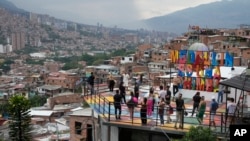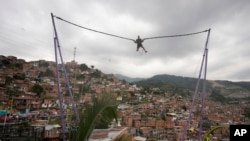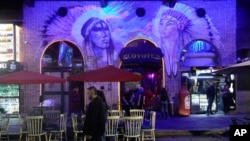The lush valley enveloping Medellin was once the heart of a brutal war involving the Colombian government, drug cartels and a smattering of other armed groups.
But a sharp dip in violence in the country's second-biggest city has attracted a flood of tourists to its vivid colors, busy cafes and booming nightlife. About 1.4 million visited last year, many of them American.
Now the tourism boom has presented officials with a new set of dark challenges, including an uptick in sex trafficking and the killing of tourists and Colombian women after rendezvous on dating apps.
"This area has spun out of control," Medellin Mayor Federico Gutiérrez said recently while touring a park known for the sex trade.
Sex and drug tourism has long been a problem in Medellin, but the dangers came to a head late last year. Between November and December, eight American men were killed, many after meeting local women who are often used as pawns by criminal groups that target foreigners.
The killings prompted the U.S. Embassy in Bogota to warn in January that some tourists had been slipped drugs and were later robbed or killed. American officials cautioned men against using dating apps. The apps offer a way to seek out sex workers, whose business is not criminalized in Colombia.
Medellin lead prosecutor Yiri Milena Amado Sanchez said most of the recent killings followed similar scripts: A tourist contacts a local woman through social media or a dating app. When they meet, the man is handed a drink spiked with a substance such as scopolamine, which can cause people to fall unconscious and block their memories. The victims lose their belongings and, in some cases, their lives.
Of the killings, the most is known about the death of Tou Ger Xiong, an activist and comedian from Minnesota who went on a date with a Medellin woman, police say.
After meeting the woman, Xiong was kidnapped on Dec. 10, tortured, beaten and robbed. Despite his family paying a ransom for his release, he was taken to a nearby wooded area and thrown down a 250-foot cliff. He was found dead the next day.
Colombian authorities have not suggested that he was involved in prostitution. They said Xiong went out several times with the woman, who has been charged in the case, along with two men.
Friends and relatives described Xiong as a gregarious man who loved to travel, especially to Colombia, where he had friends.
"It's almost like a second home; he loved it there," his brother, Eh Xiong, told the Star Tribune of Minneapolis, adding that his brother knew about the U.S. government warnings, but that he assumed only "the best in people."
Just this year, authorities have investigated the deaths of five more tourists, including a Dutch visitor found dead in a hotel, three Americans and a Lithuanian, who may have died by suicide.
Foreigners, too, have been behind some of the violence.
Earlier this month, the body of 20-year-old Colombian Laura Lopera was found jammed inside a suitcase. Authorities say her middle-aged Canadian ex-boyfriend, whom she met on a dating app, was likely behind the death.
Gutiérrez, the Medellin mayor, said the boyfriend fled the country and is now being pursued by Interpol. The Associated Press contacted the suspect over social media but did not receive a response.
The Canadian Embassy in Bogota said it was tracking the case but could not share more information due to privacy concerns.
"How sad and painful it is to learn of another femicide," Gutiérrez wrote on X, formerly Twitter. "I send my solidarity to her family."
The rise in tourism has also coincided with an uptick in sexual exploitation and trafficking in a place where rates of violence against women are already sky-high. In 2023, the city documented 1,259 cases of possible sexual exploitation of minors, a nearly 60% increase from the year before, according to data collected by the city.
Much of the city's sex work is also fueled by poverty and a migration crisis from neighboring Venezuela. Vulnerable women often sell sex to make ends meet. That was the case for one young sex worker, who fled economic crisis in Venezuela five years ago.
Every weekend, she walks dressed up through Lleras Park, which is surrounded by clubs frequented by foreign tourists. The small park is a hub for Medellin's sex industry.
"An American will pay 100 or even 200 dollars for sex, but a Colombian never pays that much," she said, speaking on condition of anonymity for security reasons.
Far from making a lucrative salary, she needed to scrape together at least $50 to pay for the room where she lives with her 8-year-old daughter and her mother.
"Some think that we are going to harm them," she said, referring to the crimes against tourists. "But not all of us are criminals."
On a recent night, dozens of police officers and local government officials patrolled the park, accompanied by Mayor Gutiérrez.
They asked for identification from women entering the park through police checkpoints. Most were let through, but a couple of teenagers were stopped and taken into a van. When the police left, the area once again filled with sex workers of different ages.
Despite the rise in sex tourism, many visitors to Medellin are pulled in by its vibrant culture, the stunning natural beauty of the valley and the city's complicated history.
In a hillside neighborhood known as Comuna 13, hundreds of people take walking tours each day to see the area's transformation.
The neighborhood was once a battleground for fighting among drug cartels, leftist guerrillas, military forces and government-linked paramilitary groups. The dead were buried in mass graves.
While the area still struggles with gang problems, tourists walk through colorful streets connected by electric staircases. Visitors take photos of intricate murals painted by local artists and shop for handicrafts in small stores.
In the middle of a tour, 38-year-old Ola Aiyedun of New York stopped to take some pictures with two friends. He said he wasn't worried about safety or the warning to avoid dating apps because he didn't come to Colombia in search of a partner.
"Colombia has more to offer than just women," Aiyedun said.










